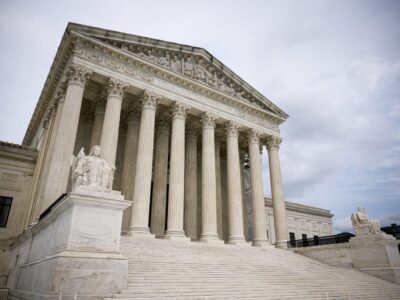Trump Goes to War Against Environmental Justice
Apparently it’s “woke” to worry about excessive pollution in minority communities.
An executive order dating back to Clinton requires all agencies to make environmental justice part of their missions. They are required to consider whether their actions have “disproportionately high” impacts on minority and low-income communities. Those last two sentences were true all the way through Trump’s first term and the Biden years. But no more.
President Trump just revoked the Clinton order, making it clear that agencies should no longer consider how their actions impact disadvantaged communities. This radical step follows in the wake of an earlier Trump order eliminating environmental justice offices in agencies.
To implement this order, agencies will have to eliminate their own environmental justice regulations. At that point, the door will be open to judicial review. I think agencies will have a hard time justifying the repeals. Trump’s executive order says that its purpose is “ending illegal preferences and discrimination.”
As I discuss at length in a recent article, there is no reason to think that the Clinton order violates either the Constitution or any civil rights law. Court have repeatedly upheld rules targeting the disparate impact of regulations on people of color. In addition, even if the environmental justice provisions are problematic in their application to race, there’s not even a sliver of a legal argument against their application to low-income communities in general.
Some conservatives have argued that the disparate-impact analysis – the approach taken in Clinton’s executive order – is inconsistent with the Supreme Court’s ruling against affirmative action. But the two are quite different. Affirmative action is an effort by the government to benefit minorities. Disparate-impact analysis is an effort by government to avoid harming them. It takes a high degree of sophistry to equate the two.
Also, unlike affirmative action, a gain to one group in environmental protection does not equal a loss to another. Only one person can get a single slot in a college, but stopping a polluter who is harming a minority community does not deny white communities of any opportunities. In fact, quite often, they too will benefit from halting the pollution.
Finally, as I explained in a follow-up paper, affirmative action has been a highly divisive issue on the Supreme Court for decades, so the ruling against it was not a surprise. In contrast, there have been only a couple of complaints by Justices about disparate-impact analysis in the over forty years it has been part of the law.
Thus, there is little or no basis for Trump’s claim that Clinton’s environmental justice order violated either civil rights laws or the Constitution. Maybe the Supreme Court will make a radical change in the law with no prior warning, but that is the only hope for Trump’s claim that disparate impact analysis to protect minorities is unconstitutional. And not even that would justify eliminating disparate impact analysis to protect the poor.
Trump’s embrace of this extremist view is an indication of just how much more radical his second term may be compared with his first. Agencies that follow his order to eliminate their own environmental justice rules are courting judicial reversal.
Reader Comments
10 Replies to “Trump Goes to War Against Environmental Justice”
Comments are closed.







The Biden administration’s use of Environmental Justice was predicated on the assumption that white Republicans are systemic racists who hate black people and use “pollution” to target and cause harm to black communities and other minorities whom they allegedly “hate”.
We are not racist bigots, that was a big political lie that Trump has now remedied. Curse those who resort such lies.
It is not predicated on that assumption, it is predicated on the proven fact that time and time again industrial and chemical projects that will have the effect of massive pollution of the surrounding areas are in done in low-income communities that are predominantly people of color. It is not about targeting, it is about protection of those who do not have the political power or means to resist the intentional pollution of their communities. Not everything that seeks to remedy private actions that impact the disenfranchised is an attack on “white republicans”. I suggest you try reading some books instead of scrolling X all day.
Have a good one!
interesting that Trump did not expressly revoke President Biden’s Executive Order 14096 (Revitalizing Our Nation’s Committment to Environmental Justice for All) that was published in the April 26, 2023 issue of the Federal Register(88 FR 25251).
It is unclear if this was an oversight or if EO 14096 will be rescinded in later presidential memorandum.
your calling this move “radical” is a reflection that you are writing as an advocate and not an objective professor of law. reasonable minds can differ without being called “radical”.
Radical in its literal sense of “to the root” seems like a perfectly apt description, especially when the same EO withstood Trump’s first Administration. Indeed, many of these same actors have been openly congratulating themselves on just how “radical” they’ve become, and I imagine view it as a compliment. Even if law professors weren’t allowed to have viewpoints and reach conclusions — an odd proposition! — this one is an accurate observation.
The author and law professor knows that EJ issues have traditionally been addressed under NEPA. The Biden EJ program specifically imposed additional regulatory burdens on the overwhelmingly majority of project developers who are conservative male businessmen, when they apply for federal environmental permits.
Biden’s EJ program was official government mandated racism and that is why Trump terminated it.
Jim – I try not to respond to every comment, but in this case I think you’ve missed a key aspect of the situation. What you’ve said explains why Trump eliminated Biden’s environmental justice orders. But it doesn’t explain why he eliminated the 1990s executive order, which he hadn’t touched in his first term.
Disparate impact in the context of employment and housing is most definitely zero sum, and it violates the CRA and 14A.
Disparate impact in these contexts is also utterly bad policy, as studies in the field of industrial organizational psychology have converged on the well-replicated finding “diversity-validity dilemma,” whereby there is an inverse relationship between the predictive validity of an employment test and the non-asian diversity that test yields.
Therefore, employers must engage in soft quotas to avoid disparate impact. The business necessity analysis is amorphous, standardless, and doesn’t track valid IOS studies (otherwise every minimally validated test would satisfy the business necessity test). Armed with this vague standard, a sufficiently-motivated left wing judge could fault employers for aspects of employment tests that have no or little bearing on validity.
The question of whether disparate impact violates equal protection in the context of environmental regulations is distinct. But if a litigant (such as a business) suffers a harm that is causally connected to an environmental regulation implemented due to disparate impact considerations (i.e.: forbdden racial beancounting) then the litigant should have a claim.
In sum, you are wrong
In your article you write:
“If the Court does decide to subject race-neutral programs of all kinds to strict scrutiny whenever the government considered the program’s ability to reduce racial disparities, the effect on health or safety regulations would be the least of the fallout.”
If goverments could avoid strict scrutiny merely by asserting that a dominant motive behind legislation/regulation was reducing disparity (i.e.: racial balancing) then equal protection would be a dead letter in a multiethnic democracy.
Ethnic interest groups and left wing activists regularly use racial disparity reduction as a cover to secure what are in effect giveaways.
I hope at some point the legal professoriate will realize that in no country/society–historically or contemporaneously–have all ethnic groups even approached representation in various positions of politcal/financial status remotely in proportion to their share of the population.
If we are to be a functioning society that achieves technological progress, the legal professoriate must abandon it ugly third world racial beancounting fixation at once
The existence of DEI reflects the erosion of democracy.